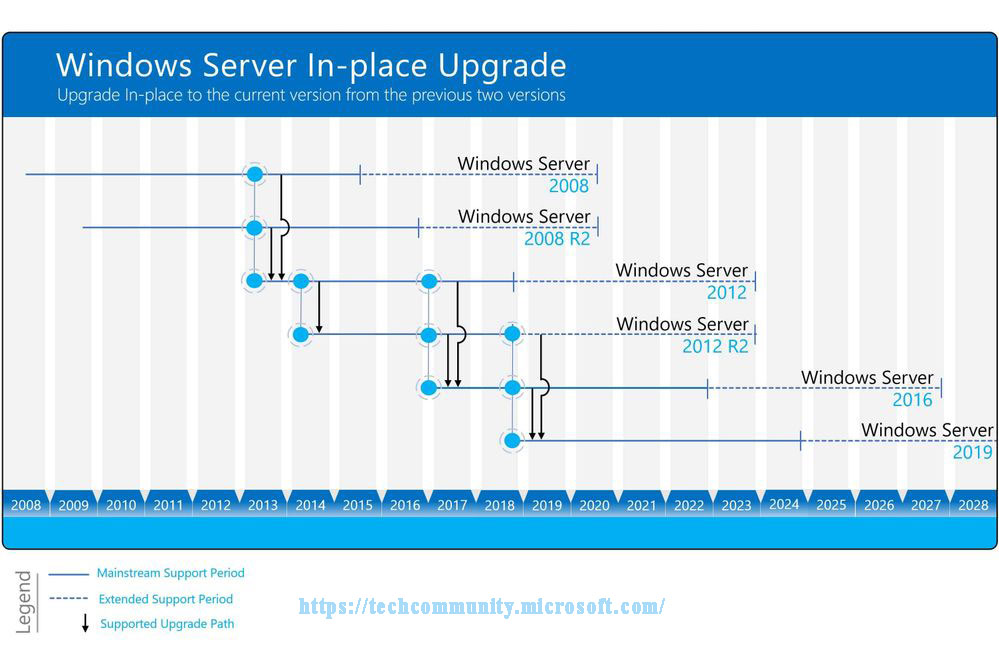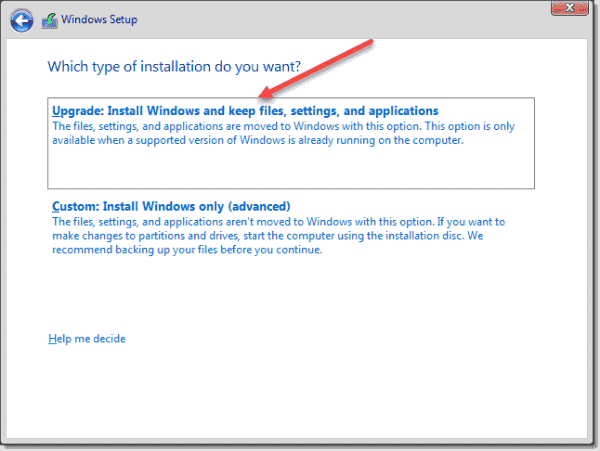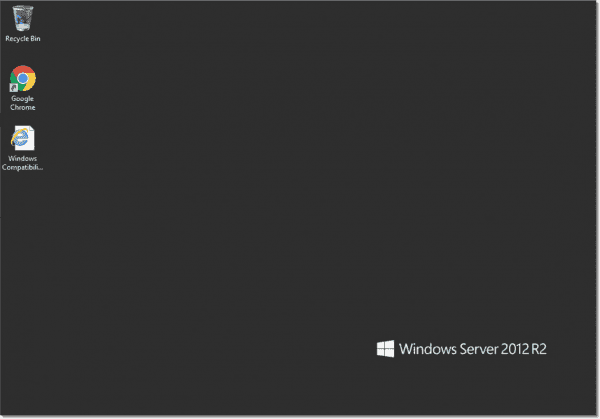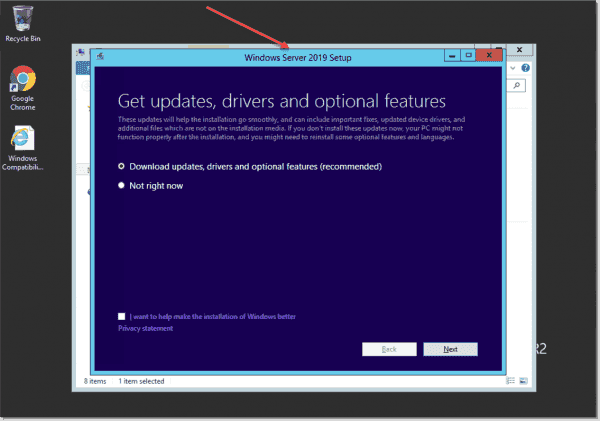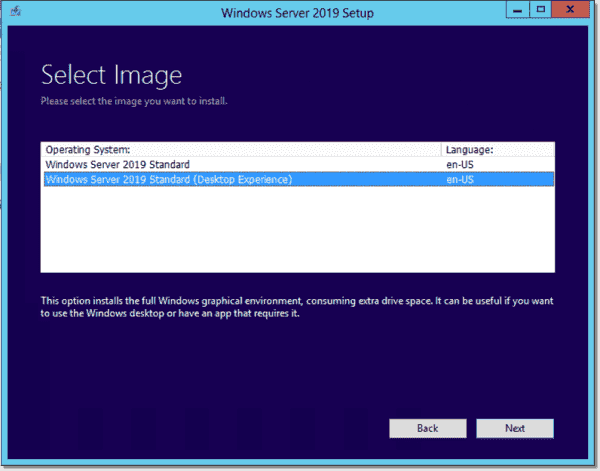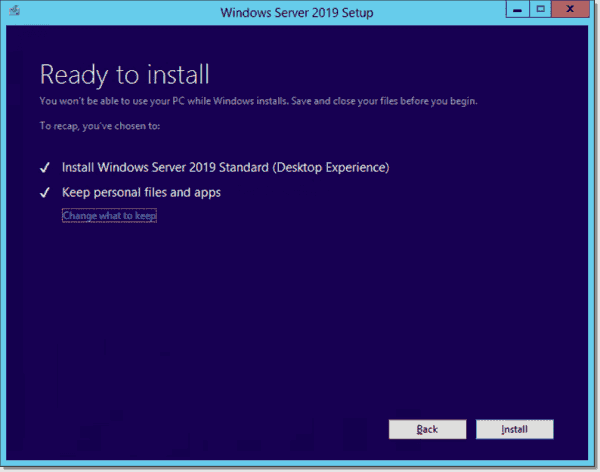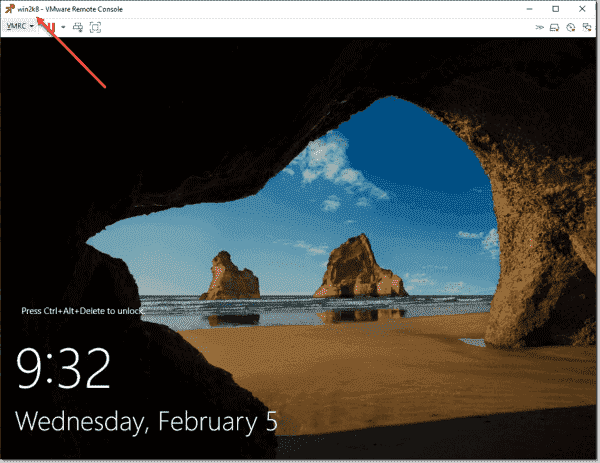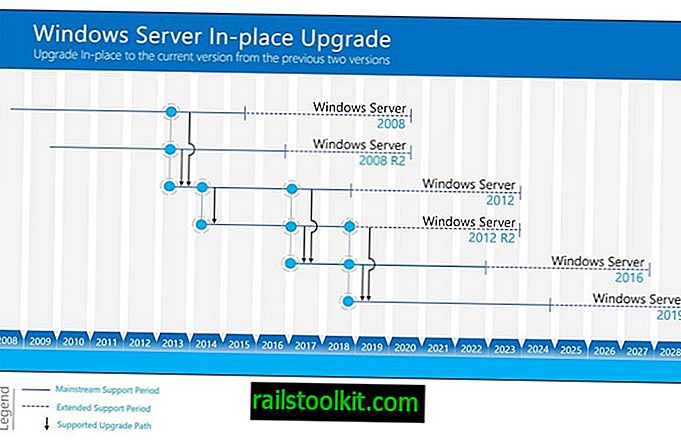As you know the Windows Server 2008 and Windows Server 2008 R2 are out of support on January 14th, 2020. Customer will need to upgrade their Windows Server 2008 and Windows Server 2008 R2 to a newer version of Windows Server or migrate these servers to Microsoft Azure and get three years of extended security support for free, which will give you more time to upgrade your servers, redeploy your apps or rearchitect your applications. If you want to have more information about how to migrate your servers to Azure, check out the Azure migration center. There are many ways you can migrate your server applications to a newer version of Windows Server. This blog post covers how you in-place upgrade Windows Server 2008 R2 to Windows Server 2019. You can find more information about Windows Server 2019 installations and upgrades on Microsoft Docs.
To help you with Windows Server upgrades, the Windows Server team created Windows Server Upgrade Center, which gives you step-by-step guidance for modernizing your datacenter.
Upgrade path
You can directly do an in-place upgrade to Windows Server 2019 from Windows Server 2016 and Windows Server 2012 R2. This means, to upgrade from Windows Server 2008 R2 to Windows Server 2019, you will have two consecutive upgrade processes.
- First, you upgrade Windows Server 2008 R2 to Windows Server 2012 R2
- Secondly, you will upgrade Windows Server 2012 R2 to Windows Server 2019

Not all server roles and applications are supported to be migrated in older versions of Windows Server. Read the specific documentation for your operating system scenario, for example upgrading roles to Windows Server 2016. As an alternative, you can also redeploy the applications on a fresh installation of Windows Server 2019.
Planning the Upgrade
Before you start in-place upgrade your servers, make sure you plan your upgrade and make sure you have all the information, to avoid surprises at the end of the migration. The Windows Server Upgrade Center helps you with a checklist which includes, for example, the following:
- What software and roles are installed on the server and are they supported and working with newer versions of Windows Server. I recommend doing a software inventory and check if the applications and roles are supported.
- Have some tests ready to check if the application still works after the upgrade. It is a good thing to run through these tests before the upgrade as well, so you can confirm everything is working correctly.
- If it is a physical server, do you have drivers and firmware updates for the new Windows Server version available?
- Think about backup software and antivirus, you might need to uninstall these during the update process and reinstall it after the upgrade is done.
- Make sure your server is up-to-date and fully patched before doing an in-place upgrade.
- Planning the timeframe for the upgrade. In-place upgrades take some time, make sure you have a long enough maintenance window planned. Also make sure you communicate the maintenance window, so users know that the application or service is not available.
- Make sure you have a backup of the server before you start the upgrade process, and make sure you can also restore from that specific backup.
- If possible, test the upgrade process with a non-production server.
- Make sure you have enough disk space for the upgrade.
- Gather your system information before the upgrade.
Collect system information
Before you start the upgrade process you should also collect the following system information. You can use the following to commands. Please save the output on another location.
mkdir C:info systeminfo > C:infosysteminfo.txt ipconfig /all > C:infoipconfig.txt
Please copy and save the systeminfo.txt and ipconfig.txt file on another system.

Before proceeding with the In-place Upgrade
I know I have mentioned it before, make sure you have a backup you can restore of the server you are performing the in-place upgrade. Also, make sure that you are aware that the following upgrade processes cause downtime.
Upgrade Windows Server 2008 R2 to Windows Server 2012 R2
Insert the setup media for Windows Server 2012 R2 and start the setup.exe.
Click Install now.
If your server is connected to the internet, make sure you click on Go online to install updates now (recommended). This will download the latest updates to the installer.
Enter the Windows Server License Key for Windows Server 2012 R2 if needed. If you are not asked for the license key, you can skip that step.
Select the right Windows Server edition you want to install. Also make sure you select Server with a GUI or Server Core Installation, depending on your needs.
Read and accept the license terms. Select I accept the license terms.
For an in-place upgrade select Upgrade: Install Windows and keep files, settings, and applications.
The setup will check the application compatibility and create a compatibility report.
Next, press Confirm to start upgrading Windows.
The setup will complete and automatically reboot. When the upgrade is done, you will see the Windows Server 2012 R2 logon screen.
Post Upgrade to Windows Server 2012 R2
After the upgrade to Windows Server 2012, log in and check if the server has been successfully upgraded. Make sure you test if the applications are running like expected and if users can access the application. Make sure that the IP and firewall configuration of your server still allows clients to access your system.
You can run the following command to see that you successfully upgraded to Windows Server 2012:
systeminfo

If there has been an issue with the upgrade, make a copy and zip the %SystemRoot%Panther (usually C:WindowsPanther) directory and contact support.
If everything works as expected, you can install the latest Windows Server 2012 R2 updates, and make sure your server is fully patched. Before you move to the Windows Server 2012 R2 to Windows Server 2019 upgrade, I also recommend that you create a backup of the server, in that case, you don’t lose the work you did from 2008 R2 to 2012 R2.
Upgrade Windows Server 2012 R2 to Windows Server 2019
Insert the setup media for Windows Server 2019 and start the setup.exe.
Click Install now.
If your server is connected to the internet, make sure you click Download and install updates, drivers and optional features (recommended). This will download the latest updates to the installer.

Enter the Windows Server License Key for Windows Server 2019 if needed. If you are not asked for the license key, you can skip that step.

Select the right Windows Server edition you want to install. Also make sure you select Windows Server 2019 Datacenter (Desktop Experience) or Windows Server 2019 Datacenter (Core), depending on your needs.

Read and accept the license terms. Select I accept the license terms.

For an in-place upgrade, select Keep personal files and app and click Next.

The setup will check the application compatibility and create a compatibility report.
Next, press Install to start upgrading Windows.

The setup will complete and automatically reboot. When the upgrade is done, you will see the Windows Server 2019 logon screen.

Post Upgrade to Windows Server 2019
After the upgrade to Windows Server 2019, log in and check if the server has been successfully upgraded. Make sure you test if the applications are running like expected and if users can access the application. Make sure that the IP and firewall configuration of your server still allows clients to access your system.
You can run the following command to see that you successfully upgraded to Windows Server 2019:
systeminfo
If there has been an issue with the upgrade, make a copy and zip the %SystemRoot%Panther (usually C:WindowsPanther) directory and contact support.
If everything works as expected, you can install the latest Windows Server 2019 updates, and make sure your server is fully patched. I also recommend that you create a backup of the server; in that case, you don’t lose the work you did.
I also highly recommend that you have a look at Windows Containers to modernize your applications. Check out our full video here on Microsoft Channel 9:
Conclusion
There are many ways you can upgrade or migrate your applications, in-place upgrade is just one of them, and might not always fit. However, in some scenarios, it is the easiest way to get to a newer version of Windows Server. I hope this gives you an overview about how you can do in-place upgrades from Windows Server 2008 R2 to Windows Server 2019. If you have any questions or tips for the upgrades, leave a comment below.
-
Partition Wizard
-
Clone Disk
- How to Upgrade Windows Server 2008 before Support Ends
By Ariel | Follow |
Last Updated February 07, 2021
As you know, Windows Server 2008 will end its support on January 14th. It’s highly recommended that you upgrade Windows Server 2008. But you may wonder whether it’s complicated to upgrade Windows Server 2008. Take it easy, there are some useful tips.
Windows Server 2008 End of Life Is Looming
Microsoft announces that the date of Windows Server 2008 R2 and Windows server 2008 end of life is planned on January 14th, 2020. Once Windows Server 2018 end of life occurs, Windows Server 2008 will not provide these services such as free security updates on-premises, non-security updates, free support options, and online technical content updates.
So, it’s urgent for customers to make a decision. You can upgrade Windows Server 2008 to 2019 before Windows Server 2008 end of life, or migrate Windows Server to Microsoft Azure.
Tip: Windows Server 2008 upgrade requires lots of time and effort, which may bring some unexpected risks. So please be sure you back up important data in advance. Here we want to recommend you a professional backup software MiniTool software.
In-Place Upgrade Windows Server 2008 to Windows Server 2019
There are many ways you can upgrade Windows Server 2008 to a new version of Windows Server. This article mainly focuses on in-place upgrade Windows Server 2008 to 2019. Well, you can look for more information about Windows Server 2019 installation and upgrades on Microsoft Docs.
To help users upgrade Windows Server smoothly, Windows Server Upgrade Center provides you step-by-step guidance for the upgrade.
Here it’s recommended that you do an in-place upgrade to Windows Server 2019 from Windows Server 2016 and Windows Server 2012 (R2). In other words, there are three continuous upgrades that progress to upgrade from Windows Server 2008 to Windows Server 2019.
- First, upgrade Windows Server 2008 (R2) to Windows Server 2012 (R2).
- You need to upgrade Windows Server 2012 (R2) to Windows Server 2016.
- At last, you can upgrade Windows Server 2016 to Windows Server 2019.
Before you start this in-place upgrade, there are many requirements you should pay attention to:
- Take inventory of your servers. You should check whether the applications and roles installed are supported within newer versions of Windows Server.
- If it is a physical Server, you should check whether you have drivers and firmware for the new Windows Server.
- Make sure you have enough disk space to update Windows Server 2008 to 2019.
- Make sure your system information is collected before the upgrade.
- Make sure you have a backup of the Server before the update and make sure you can also restore it from that backup.
Migrate Windows Server 2008 into Microsoft Azure
In addition, to do an in-place upgrade, you can also Migrate Windows Server 2008 to Microsoft Azure, which enables you to get three years of extended security support freely. So that you have more time to upgrade your servers, and redeploy your apps.
There is a full range of tools available in Azure Migration Center that can help you estimate your current on-premises environment as well as migrate Windows Server 2008 into Azure, including the operating system, applications, and data into Azure.
It is easy to migrate your Windows Server 2008 machines to Azure. You just need to perform basic steps.
Step 1. You need to create a storage account in your Azure account.
Step 2.Then you can start to replicate the Server to your storage account with Azure Site Recovery.
Step 3. You can use Azure Site Recovery to make Server running on Hyper-V Servers, physical Servers, and VMware virtual machines.
Final Words
Well, all related information and helpful tips about Windows Server 2008 end of life has been told to you. Now, it’s high time to upgrade your Windows Server 2008 to a new version of Windows Server.
About The Author
Position: Columnist
Ariel is an enthusiastic IT columnist focusing on partition management, data recovery, and Windows issues. She has helped users fix various problems like PS4 corrupted disk, unexpected store exception error, the green screen of death error, etc. If you are searching for methods to optimize your storage device and restore lost data from different storage devices, then Ariel can provide reliable solutions for these issues.
-
Partition Wizard
-
Clone Disk
- How to Upgrade Windows Server 2008 before Support Ends
By Ariel | Follow |
Last Updated February 07, 2021
As you know, Windows Server 2008 will end its support on January 14th. It’s highly recommended that you upgrade Windows Server 2008. But you may wonder whether it’s complicated to upgrade Windows Server 2008. Take it easy, there are some useful tips.
Windows Server 2008 End of Life Is Looming
Microsoft announces that the date of Windows Server 2008 R2 and Windows server 2008 end of life is planned on January 14th, 2020. Once Windows Server 2018 end of life occurs, Windows Server 2008 will not provide these services such as free security updates on-premises, non-security updates, free support options, and online technical content updates.
So, it’s urgent for customers to make a decision. You can upgrade Windows Server 2008 to 2019 before Windows Server 2008 end of life, or migrate Windows Server to Microsoft Azure.
Tip: Windows Server 2008 upgrade requires lots of time and effort, which may bring some unexpected risks. So please be sure you back up important data in advance. Here we want to recommend you a professional backup software MiniTool software.
In-Place Upgrade Windows Server 2008 to Windows Server 2019
There are many ways you can upgrade Windows Server 2008 to a new version of Windows Server. This article mainly focuses on in-place upgrade Windows Server 2008 to 2019. Well, you can look for more information about Windows Server 2019 installation and upgrades on Microsoft Docs.
To help users upgrade Windows Server smoothly, Windows Server Upgrade Center provides you step-by-step guidance for the upgrade.
Here it’s recommended that you do an in-place upgrade to Windows Server 2019 from Windows Server 2016 and Windows Server 2012 (R2). In other words, there are three continuous upgrades that progress to upgrade from Windows Server 2008 to Windows Server 2019.
- First, upgrade Windows Server 2008 (R2) to Windows Server 2012 (R2).
- You need to upgrade Windows Server 2012 (R2) to Windows Server 2016.
- At last, you can upgrade Windows Server 2016 to Windows Server 2019.
Before you start this in-place upgrade, there are many requirements you should pay attention to:
- Take inventory of your servers. You should check whether the applications and roles installed are supported within newer versions of Windows Server.
- If it is a physical Server, you should check whether you have drivers and firmware for the new Windows Server.
- Make sure you have enough disk space to update Windows Server 2008 to 2019.
- Make sure your system information is collected before the upgrade.
- Make sure you have a backup of the Server before the update and make sure you can also restore it from that backup.
Migrate Windows Server 2008 into Microsoft Azure
In addition, to do an in-place upgrade, you can also Migrate Windows Server 2008 to Microsoft Azure, which enables you to get three years of extended security support freely. So that you have more time to upgrade your servers, and redeploy your apps.
There is a full range of tools available in Azure Migration Center that can help you estimate your current on-premises environment as well as migrate Windows Server 2008 into Azure, including the operating system, applications, and data into Azure.
It is easy to migrate your Windows Server 2008 machines to Azure. You just need to perform basic steps.
Step 1. You need to create a storage account in your Azure account.
Step 2.Then you can start to replicate the Server to your storage account with Azure Site Recovery.
Step 3. You can use Azure Site Recovery to make Server running on Hyper-V Servers, physical Servers, and VMware virtual machines.
Final Words
Well, all related information and helpful tips about Windows Server 2008 end of life has been told to you. Now, it’s high time to upgrade your Windows Server 2008 to a new version of Windows Server.
About The Author
Position: Columnist
Ariel is an enthusiastic IT columnist focusing on partition management, data recovery, and Windows issues. She has helped users fix various problems like PS4 corrupted disk, unexpected store exception error, the green screen of death error, etc. If you are searching for methods to optimize your storage device and restore lost data from different storage devices, then Ariel can provide reliable solutions for these issues.
|
Винтажный сисaдмин 635 / 35 / 4 Регистрация: 16.03.2021 Сообщений: 122 |
|
|
1 |
|
|
25.03.2021, 14:14. Показов 5880. Ответов 15
Всем здравия.
0 |
|
Модератор 6871 / 3818 / 477 Регистрация: 13.03.2013 Сообщений: 14,058 Записей в блоге: 9 |
|
|
25.03.2021, 14:31 |
2 |
|
Вопрос заключается в том, апгрейдится ли при этом сама лицензия? Весьма странно, что при наличии лицензии Вы не задали этот вопрос представителям майкрософта.
0 |
|
233 / 223 / 46 Регистрация: 12.12.2012 Сообщений: 1,928 |
|
|
25.03.2021, 15:05 |
3 |
|
Естественно Вам нужна лицензия Апгрейд Вам не дает право использовать новую ОС, без купленной на нее лицензии. Ну и надеюсь это не терминальный сервер, так как апгрейд in-place он не поддерживает.
1 |
|
Винтажный сисaдмин 635 / 35 / 4 Регистрация: 16.03.2021 Сообщений: 122 |
|
|
25.03.2021, 15:32 [ТС] |
4 |
|
Весьма странно, что при наличии лицензии Вы не задали этот вопрос представителям майкрософта. Спросил в чате у робота, в ответ на мой вопрос прислали ссылку, что я указал выше.
Естественно Вам нужна лицензия Хотелось бы разораться, например, наличие лицензии от Windows 7 дает право использовать Windows 10.
Ну и надеюсь это не терминальный сервер Роль терминального сервера не поднята.
0 |
|
233 / 223 / 46 Регистрация: 12.12.2012 Сообщений: 1,928 |
|
|
25.03.2021, 15:48 |
5 |
|
Ded Matvey, ну с семеркой это тоже не работает. Вам всё равно нужно купить лицензию на десятку. — Да, раньше была возможность апгрейда конкретно для семерки, на десятку, без купли лицензии самой десятки, но в каком-то году, майкрософт изменил политику и теперь такое не работает, потому нужно покупать лицензию. А вообще тему лицензирования лучше обсуждать с манагерами у которых Вы покупаете ПО, это их работа и они Вам обязаны достоверно и точно объяснить, что и как лицензируется. Но факт в том, что апгрейд на более новую ОС требует её покупки. А так же CAL лицензии, если это какой-нибудь терминальный сервер или СУБД MS SQL.
0 |
|
Модератор 6871 / 3818 / 477 Регистрация: 13.03.2013 Сообщений: 14,058 Записей в блоге: 9 |
|
|
26.03.2021, 06:22 |
6 |
|
Спросил в чате у робота А причем тут робот? Позвоните на горячую линию и спросите.
ну с семеркой это тоже не работает Еще как работает.
0 |
|
Винтажный сисaдмин 635 / 35 / 4 Регистрация: 16.03.2021 Сообщений: 122 |
|
|
26.03.2021, 10:21 [ТС] |
7 |
|
с семеркой это тоже не работает В том то и дело, что работает: ключами от семерки спокойно активируется десятка при условии соблюдения редакций.
Позвоните на горячую линию и спросите. Сами то звонили? Там также говорит робот, предлагая нажимать 1, 2, 3 с вариантами «Вашей проблемы». Добавлено через 2 часа 31 минуту
0 |
|
233 / 223 / 46 Регистрация: 12.12.2012 Сообщений: 1,928 |
|
|
26.03.2021, 11:07 |
8 |
|
Maks, Ded Matvey, ну вопрос не технического характера. Относительно лицензирования Вы станете пиратом. Лавочку прикрыли 30 июля 2016 года. Сейчас Вы должны покупать лицензию на десятку. https://answers.microsoft.com/… 6cabf7b8da Ded Matvey, то же самое я Вам сказал, что и Vector BCO. Так же стоит понимать, что данный форум является не офф поддержкой microsoft, а просто свободный форум заинтересованных.
1 |
|
Модератор 6871 / 3818 / 477 Регистрация: 13.03.2013 Сообщений: 14,058 Записей в блоге: 9 |
|
|
26.03.2021, 12:24 |
9 |
|
Относительно лицензирования Вы станете пиратом. Лавочку прикрыли 30 июля 2016 года. Пруф можно? И как Вы объясните то, что при активации «десятки» ключом от «семерки» во-первых, активация проходит без проблем, а во-вторых, в «десятку» по итогу подставляется другой ключ?
0 |
|
Винтажный сисaдмин 635 / 35 / 4 Регистрация: 16.03.2021 Сообщений: 122 |
|
|
26.03.2021, 12:27 [ТС] |
10 |
|
https://answers.microsoft.com/… 6cabf7b8da Это «лавочка» по получению десятки с пиратских дистрибутивов, не имеющих лицензий.
0 |
|
Робот сгибальщик 831 / 456 / 95 Регистрация: 29.07.2020 Сообщений: 2,345 Записей в блоге: 7 |
|
|
26.03.2021, 15:21 |
11 |
|
Вряд-ли заработает.
0 |
|
Модератор 6871 / 3818 / 477 Регистрация: 13.03.2013 Сообщений: 14,058 Записей в блоге: 9 |
|
|
26.03.2021, 15:44 |
12 |
|
Ded Matvey, почему бы Вам не попробовать установить WS2019 на виртуалку и активировать ее ключом от WS2008?
1 |
|
233 / 223 / 46 Регистрация: 12.12.2012 Сообщений: 1,928 |
|
|
26.03.2021, 15:47 |
13 |
|
Maks, ну пруф собственно выше. Если вы ранее обновили свою лицензионную версию Windows 788.1 до Windows 10 на текущем оборудовании, вы можете повторно выполнить обновление до Windows 10 в любое время. До 29 июля 2016 г. Ded Matvey, я не вижу там такого. Возможно я ошибаюсь. Лучше проконсультироваться с манагерами. Я не так в теме лицензирования силен. Но на том же technet пишут тоже самое. Можно там уточнить.
0 |
|
Винтажный сисaдмин 635 / 35 / 4 Регистрация: 16.03.2021 Сообщений: 122 |
|
|
26.03.2021, 15:48 [ТС] |
14 |
|
почему бы Вам не попробовать установить WS2019 на виртуалку и активировать ее ключом от WS2008? Видимо так и придется сделать.
0 |
|
233 / 223 / 46 Регистрация: 12.12.2012 Сообщений: 1,928 |
|
|
26.03.2021, 15:55 |
15 |
|
Maks — ключ не есть средство лицензирования. Добавлено через 1 минуту И убедитесь, что ничего на новую ОС Вы перенести не можете. Я не про технический характер, активировать ОС можно хоть общим ключом доступным в доках technet. Относительно лицензирования, Вы не можете использовать более новую ОС без её покупки. В том числе лицензии клиентского доступа. Vector BCO кстати еще раз повторю, сказал это. Добавлено через 4 минуты Я только что купил компьютер, и скоро он будет у меня, на нем установлена Windows 78.1, можно ли обновиться до 10? Нет, нельзя, акция по бесплатному обновлению до Windows 10 завершилась 29го июля 2016 года
0 |
|
Робот сгибальщик 831 / 456 / 95 Регистрация: 29.07.2020 Сообщений: 2,345 Записей в блоге: 7 |
|
|
26.03.2021, 17:08 |
16 |
|
Цены и лицензирование для Windows Server 2019
0 |
Windows Server 2008/2008 R2 have reached the end of support from Microsoft as of January 14, 2020. Running an in-place upgrade on Windows Server 2008/2008 R2 will allow upgrading to newer versions of Windows Server. Let’s see what the process looks like to run a Windows Server 2008/2008 R2 in-place upgrade to Windows Server 2019.
Contents
- Windows Server 2008/2008 R2 migration options
- Migrating on-premises Windows Server 2008/2008 R2 server to Azure
- Using Windows Server Storage migration
- In-place upgrade
- Windows Server 2008/2008 R2 in-place upgrade
- Upgrade path
- Windows Server 2008/2008 R2 in-place upgrade process
- Conclusion
- Author
- Recent Posts
Brandon Lee has been in the IT industry 15+ years and focuses on networking and virtualization. He contributes to the community through various blog posts and technical documentation primarily at Virtualizationhowto.com.
As most are aware, support for Windows Server 2008/2008 R2 has ended as of January 14, 2020. This means that if you have any Windows Server 2008/2008 R2 hosts running in your environment, you are currently in an unsupported state. There are many great options out there for migrating away from Windows Server 2008/2008 R2. In this post, we will focus on Windows Server 2008/2008 R2 in-place upgrade and see what this involves.
Windows Server 2008/2008 R2 migration options
To take a step back for a moment, there are a few options to get from Windows Server 2008/2008 R2 to a supported version of Windows Server. What are these options? When does an in-place upgrade make the most sense? The following are viable options for moving your production services and data to a supported version of Microsoft Windows Server:
- Migrate your on-premises Windows Server 2008/2008 R2 server to Azure
- Use Windows Server Storage Migration
- In-place upgrade
Migrating on-premises Windows Server 2008/2008 R2 server to Azure
Microsoft is dangling a carrot in front of businesses that may have production workloads still running inside Windows Server 2008/2008 R2 deployments. If you migrate these on-premises workloads to Azure, you will get another three years of extended security updates. Not only do you get three more years of updates and support, but it is free aside from the Azure cost.
This can be a good option for some who may already have a presence in Azure and who want the simplicity of rehosting the same exact server inside Azure. With free security updates, this allows much more time for deciding on a migration plan or refactoring of applications.
Three years of extended upgrade free when migrating to Azure (image courtesy of Microsoft)
Using Windows Server Storage migration
Windows Server Storage Migration is another option that allows using Windows Admin Center and the Windows Server Storage Migration module to migrate from a Windows Server 2008/2008 R2 platform to a supported platform such as Windows Server 2019.
Using Windows Server Storage Migration, you can completely move your data, permissions, and users and assume the identity of the server in an automated fashion; the heavy lifting is done for you. This enables easy migration of file servers running on legacy platforms up to a supported version of Windows Server.
Using the Storage Migration Service to migrate from Windows Server 2008
In-place upgrade
An in-place upgrade allows mounting the installation media for a newer version of Windows Server and running through the upgrade process on the legacy server. The Windows Server installation setup recognizes that an existing version of Windows Server is installed and will prompt you to choose between a clean installation or an upgrade. If an upgrade is chosen, the existing operating system, settings, and data are migrated (best effort) to the newer platform.
Windows Server 2008/2008 R2 in-place upgrade
There may be cases in which you simply want to keep your Windows Server 2008/2008 R2 server on-premises and upgrade it to a supported version of Windows Server and keep existing application installations in place. In this case, the in-place upgrade will most likely be the easiest option.
Upgrade path
It is important to note the upgrade path from Windows Server 2008/2008 R2 to newer Windows Server operating systems, such as Windows Server 2019. The below infographic from Microsoft helps to visualize the upgrade paths from Windows Server 2008/2008 R2 to Windows Server operating systems such as Windows Server 2012/2012 R2, Windows Server 2016, and Windows Server 2019.
Windows Server in-place upgrade to current versions of Windows Server (image courtesy of Microsoft)
If you want to perform an in-place upgrade from Windows Server 2008/2008 R2 all the way up to Windows Server 2019, what does the process look like?
You will need to perform two in-place upgrade processes. Since you can’t perform an in-place upgrade directly from Windows Server 2008/2008 R2 to Windows Server 2019, you have to first upgrade to Windows Server 2012 R2 and then perform an in-place upgrade to Windows Server 2019.
Windows Server 2008/2008 R2 in-place upgrade process
Before actually running the in-place upgrade from Windows Server 2008/2008 R2 to a newer version of Windows Server, it is best practice to audit your legacy Windows Server. It is important to consider the following:
- What roles and features are installed? Do these exist in the target version of Windows Server?
- What software and software components are installed? Are there supported versions for these in the target version of Windows Server?
- Do you have a good backup of the server? Other than creating a snapshot/checkpoint (if virtual), be sure to have a proper backup of the server.
- Do you have enough free space on your system drive to perform the upgrade? In-place upgrades require additional available free space to be successful.
- Start with the latest patch version available for your current legacy server. This helps to ensure you have the most current updates and patches available to ensure the in-place upgrade is successful.
- Test the upgrade in a lab environment if possible
Once you have considered these items and others that may be important for your particular environment, you should be able to begin the in-place upgrade.
Below is a screenshot of the Windows Setup dialog box, which opens when you run the Windows Server 2012 R2 installation media from a Windows Server 2008/2008 R2 server. Click Install Now.
Running the in place upgrade to Windows Server 2012 R2
The upgrade includes screens asking about pulling the latest updates, entering the license key for Windows Server 2012 R2, and choosing the operating system you want to install.
Select the operating system you want to install with Windows Server 2012 R2
You will eventually see the screen to choose which type of installation you want to install. Here, choose Upgrade: Install Windows and keep files, settings, and applications.
Choosing an upgrade for type of installation
After you click the Upgrade option, you will see the normal Windows installer screens that retain your settings and update your Windows Server installation. Your server will reboot several times.
Once the upgrade process has completed, you will see the freshly upgraded Windows Server 2012 R2 installation. It should contain your previous apps, data, and settings.
Windows Server in place upgrade to Windows Server 2012 R2 is successful
Now, if Windows Server 2012 R2 is not your final destination, you will need to perform another in-place upgrade to reach your target Windows Server version.
As you recall, we have to perform this same process over again to get from Windows Server 2012 R2 up to Windows Server 2019. After mounting the Windows Server 2019 install media on the newly upgraded Windows Server 2012 R2 server, we run the upgrade again. The installer will prompt you to download updates to the installer itself.
Starting the Windows Server 2019 upgrade in Windows Server 2012 R2
You will need to enter a valid Windows Server 2019 license key and also select the Windows Server 2019 image you would like to install.
Choose the Windows Server 2019 image you want to upgrade to
The wording of the upgrade vs. clean install with the Windows Server 2019 installer is a bit less obvious. On the Choose what to keep page, select Keep personal files and apps for an upgrade. Select Nothing if you want to perform a clean installation.
You will want to choose the first option for an upgrade.
Choose between an upgrade and clean install with Windows Server 2019 installer
The upgrade is ready to proceed with keeping your files and applications.
Ready to upgrade to Windows Server 2019
Just as with the upgrade to Windows Server 2012 R2, the server will reboot several times. After a short time, your server should successfully upgrade to Windows Server 2019.
Windows Server 2008 R2 successfully upgraded to Windows Server 2019
Conclusion
With the end of support from Microsoft for Windows Server 2008/2008 R2 reached as of January 14, 2020, moving production workloads off Windows Server 2008/2008 R2 should be a priority. While there are several ways to move your workloads to newer versions of Windows Server, the in-place upgrade may be the best option for those who want to keep their server on-premises and who have many custom applications, settings, and data that would be difficult to migrate to a different server.
The Windows Server 2008/2008 R2 in-place upgrade to Windows Server 2019 involves two in-place upgrades: one to Windows Server 2012 R2 and then an upgrade from 2012 R2 to Windows Server 2019. All in all, the process is straightforward and should be easy to accomplish with planned down time.
- Remove From My Forums
-
Вопрос
-
Добрый день.
Вычитал в статьях, что обновление с Server 2008R2 на 2019 возможно и делается по следующим этапам:
1. Обновление до Server 2016
2. Обновление до Server 2019
Как на практике это происходит ? Не получим ли мы после этого «клюкордром» на сервере 2019.
Может кто то пробовал на практике ?
Или лучше этим не заниматься и с нуля ставить ?
Вопрос в том, что куча информации (можно судить по моему посту о переходе на Hyper-V и 2019.
Там SQL 2008R2 в системе и 1С. Что будет с ними после этого…)
Кстати SQL 2008R2 возможно тоже до 2019 обновить ?
Спасибо.
-
Изменено
25 декабря 2020 г. 8:39
-
Изменено
Ответы
-
Там SQL 2008R2 в системе и 1С. Что будет с ними после этого…)
Этот вопрос лучше задать 1С.
А так, обновление поверх установленной системы (in-place) обычно не рекоммендуемый, но вполне себе нормальный способ обновления ОС. Например, мы сейчас обновляем парк севрвером с 2012 на 2016, и проблемы
с серверами, где установлен MS SQL — нет. Были только проблемы с серверами, где установлено приложение Varonis.ссылка на информацию по обновлению MS SQL
П.С. Все обновления можно протестировать в виртуальной среде, а перед обновлением рабочих серверов не забудьте купить новые клиентские лицензии
CAL-
Изменено
Гастарбайтер
25 декабря 2020 г. 8:59 -
Помечено в качестве ответа
Petko KrushevMicrosoft contingent staff
4 января 2021 г. 8:16
-
Изменено
Окончание поддержки Windows 7 с пакетом обновления 1 в январе 2020 года также означает прекращение поддержки Windows Server 2008 R2; Как и клиенты, работающие под управлением Windows 7 на устройствах, клиенты, использующие серверную подвеску, должны решить, что с этим делать.
Один из вариантов, который есть у клиентов Microsoft, — использовать обновление на месте для обновления до поддерживаемой версии Сервера. Путь может быть не самым подходящим для некоторых случаев использования, поскольку он включает в себя несколько обновлений, а не только одно обновление с Server 2008 R2 до Server 2019.
Microsoft опубликовала подробное руководство по использованию маршрута обновления на месте для обновления устройств под управлением Windows Server 2008 R2. Компания хочет, чтобы клиенты обновились до Windows Server 2019, но, безусловно, можно обновить ее до более старой, но все еще поддерживаемой версии Server.
Администраторы, которые хотят выбрать маршрут обновления на месте, должны выполнить всего три обновления:
- Обновите Windows Server 2008 R2 до Windows Server 2012.
- Обновите Windows Server 2012 до Windows Server 2016.
- Обновите Windows Server 2016 до Windows Server 2019.
Поддержка Windows Server 2012 и 2012 R2 заканчивается в 2023 году, и клиенты могут прекратить процесс обновления прямо тогда и там теоретически.
Есть несколько предостережений, о которых должны знать администраторы. Microsoft отмечает, что некоторые серверные роли или приложения не могут быть перенесены в более новые версии Windows Server.
Microsoft рекомендует администраторам создавать полные резервные копии серверных систем перед запуском обновления.
Администраторы должны включить в контрольный список следующие элементы, чтобы спланировать и подготовить обновление до новой версии Сервера:
- Какое программное обеспечение и роли установлены на сервере и поддерживаются ли они и работают с более новыми версиями Windows Server. Я рекомендую провести инвентаризацию программного обеспечения и проверить, поддерживаются ли приложения и роли.
- Подготовьте несколько тестов, чтобы проверить, работает ли приложение после обновления. Перед обновлением хорошо пройти через эти тесты, чтобы вы могли убедиться, что все работает правильно.
- Если это физический сервер, есть ли у вас драйверы и обновления прошивки для новой версии Windows Server?
- Подумайте о программном обеспечении для резервного копирования и антивирусах, вам может понадобиться удалить их во время процесса обновления и переустановить после завершения обновления.
- Перед обновлением на месте убедитесь, что ваш сервер обновлен и полностью исправлен.
- Планирование сроков обновления. Обновления на месте занимают некоторое время, убедитесь, что у вас запланировано достаточно продолжительное время обслуживания. Также убедитесь, что вы связываетесь с окном обслуживания, чтобы пользователи знали, что приложение или служба недоступны.
- Убедитесь, что у вас есть резервная копия сервера, прежде чем вы начнете процесс обновления, и убедитесь, что вы также можете выполнить восстановление из этой конкретной резервной копии.
- Если возможно, протестируйте процесс обновления на непроизводственном сервере.
- Убедитесь, что у вас достаточно места на диске для обновления.
- Соберите информацию о вашей системе перед обновлением.
Сервер не работает в течение достаточно долгого времени, учитывая, что три обновления на месте выполняются одно за другим, даже если все обновления выполняются без каких-либо проблем.
Основным преимуществом обновлений на месте является то, что большинство конфигураций и приложений остаются. Новая установка Server 2019 может быть быстрее, но это потребует большой работы для установки необходимых приложений и внесения изменений в конфигурацию.
Теперь вы : Вы бы использовали варианты обновления на месте или вместо этого установили новую версию операционной системы? (через Deskmodder)










